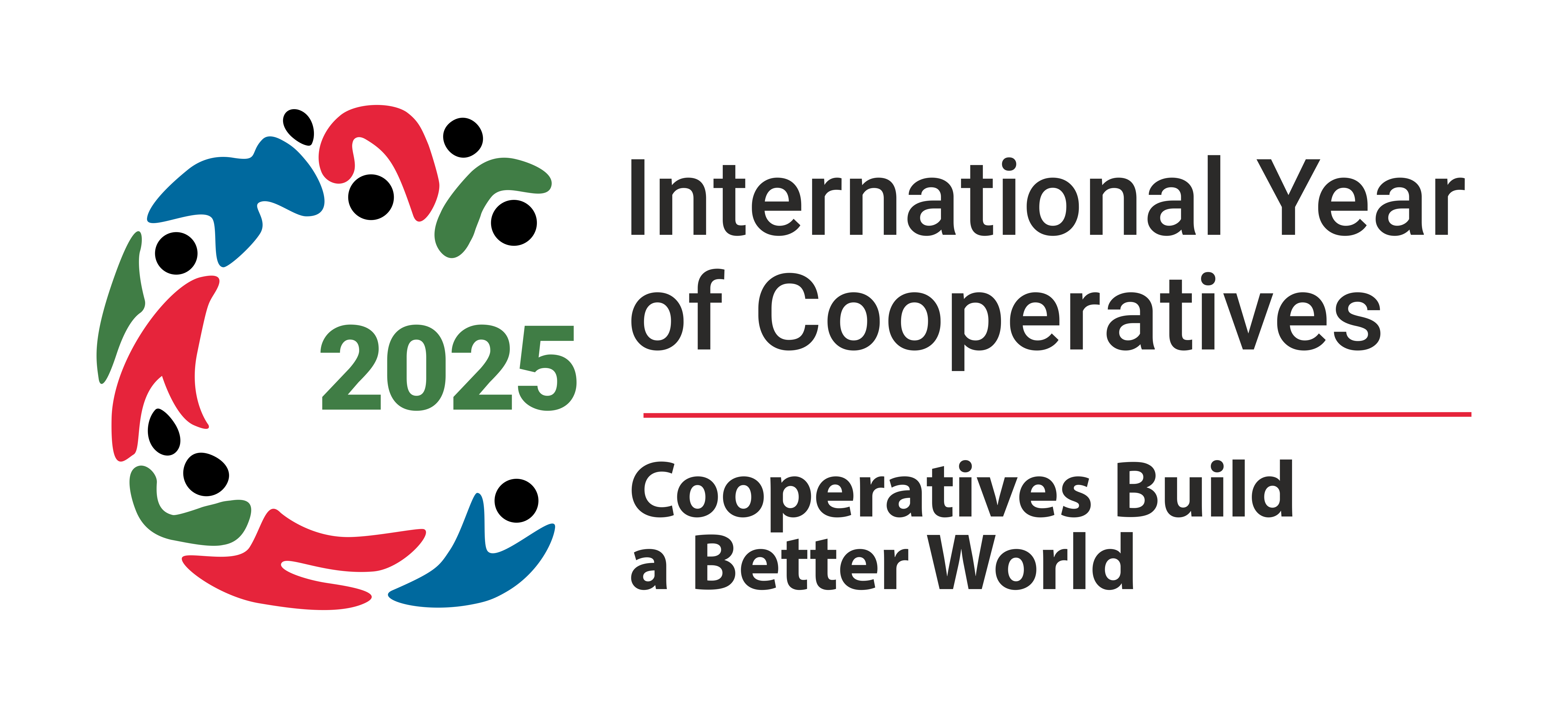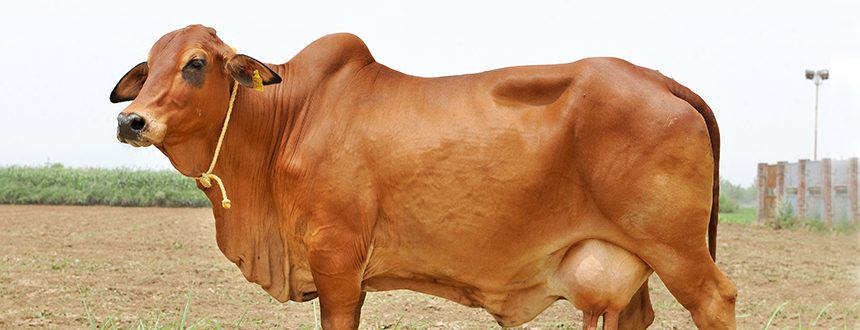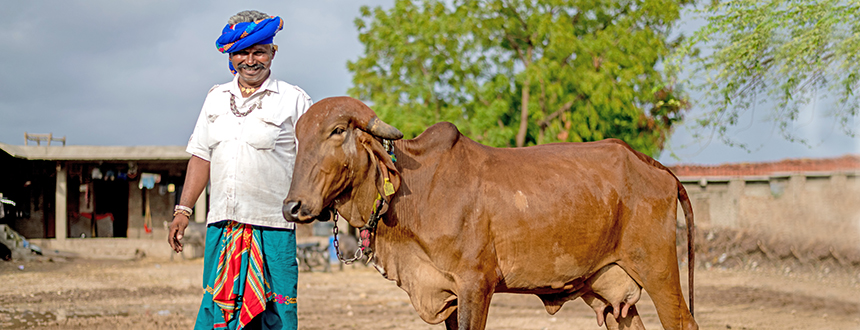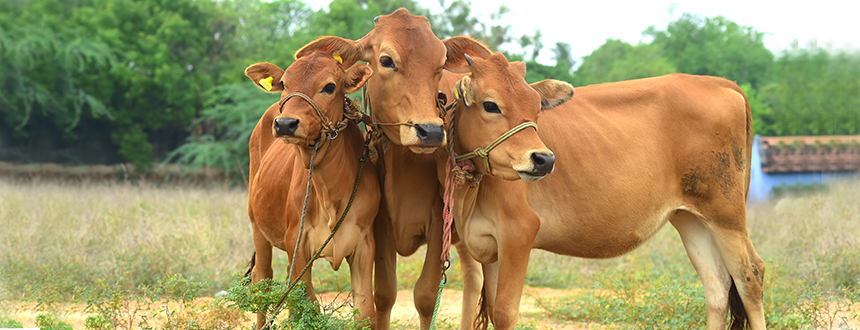Assisted Reproduction Technology
1 Embryo Transfer
Also called as Multiple Ovulation and Embryo Transfer (MOET) Technology, is used to increase the reproduction rate of superior female dairy animals. Normally, one can get one calf from a superior female dairy animals in a year. But by using MOET technology, one can get 10-20 calves in a year from a cow/buffalo. An elite cow/buffalo is administered hormones with FSH-like activity to induce super-ovulation. Under the influence of the hormone, the female produces several eggs instead of one egg produced normally. The super-ovulated female is inseminated 2-3 time at 12 hour interval during estrus and then its uterus is flushed with a medium 7th day post insemination to retrieve the developing embryos. Embryos are collected along with flushing medium in a specialised filter and the quality of embryo is assessed under the microscope. Good quality embryos either frozen and preserved for transfer in future or transferred fresh into recipient animals approximately seven days post heat date. Thus, from an elite dairy animal several calves can be produced in a year.
The first embryo transfer technology (ETT) project in the country was initiated by NDDB in 1987 by establishment of a central ET laboratory at Sabarmati Ashram Gaushala (SAG), Bidaj. The project was funded by the Dept. of Biotechnology (DBT), Ministry of Science & Technology, GoI for 5 years (April 1987 - March 1992). Under this project, NDDB established one Main ET Lab at SAG Bidaj and four Regional ET Labs at CFSP&TI, Hessarghatta (Karnataka), ABC, Salon (UP), Shri Nashik Panchavati Panjrapole, Nashik (Maharashtra) and Buffalo Breeding Centre, Nekarikallu (AP). NDDB also assisted in establishment of 14 State ET centres across the country.
SAG has done pioneering work in this field and has so far produced 14388 viable embryos and 755 calves, which is highest by any organisation in the country. Of these, 1026 embryos are of indigenous cattle breeds, from which 122 calves have been born. Besides these, around 3000 embryos of buffalo breeds have also been produced. Under the project, the first buffalo calf of India from frozen thawed embryo was born in the year 1991.
2 In- Vitro Fertilization (IVF) Technology
Also called as Ovum Pick-up and In Vitro Embryo Production (OPU-IVEP) Technology, is an advanced reproductive technology for multiplication of superior female germplasm at much faster rate. Using MOET technology one can get 10-20 calf from a superior female dairy animals in a year. But by using OPU-IVEP technology, one can get 20-40 calves in a year from a cow/buffalo. NDDB has established a state-of-the-art OPU-IVEP facility in Anand for R&D and training purposes in March 2018 with an ultimate goal to make the technology affordable to Indian dairy farmers. To acquire know-how of the technology, NDDB had collaborated with EMBRAPA Dairy Cattle, Brazil. Now the facility is fully equipped to exploit the technology.
NDDB has so far produced more than eight hundred cattle IVF embryos using sexed or conventional semen and has established more than 50 pregnancies from fresh as well as frozen IVF embryos and produced several IVF calves. One of the Gir cow produced 135 embryos from 22 OPUs, with an average of 26.7 oocyte/session and 6.13 viable embryos/session. 16 confirmed pregnancies are achieved and 10 calves are already born.
Another important job at hand is to standardise and optimise the technology in buffaloes as very little work has been done on buffaloes.
Using this technology, embryos are produced under in vitro condition i.e. inside the laboratory instead in a womb/ uterus. During OPU-IVEP procedure, oocytes are aspirated from the ovarian follicles non-surgically by an ultrasound-guided aspiration device through the vaginal wall. A vacuum system is used to recover the contents of follicles. Once follicles are aspirated from ovaries, the aspirated follicular fluid and ovum pick-up medium is passed through an appropriate filter to remove excess fluid, blood and cell debris. Then the fluid is poured in a petri dish and oocytes are searched under the microscope. Oocytes are selected based on the cumulus cell layers for further processing. The selected oocytes are washed and incubated inside the specialized CO2 incubator in vitro maturation medium for 20-22 hours. This process is called in vitro maturation (IVM). After 20-22 hours, oocytes are again assessed under the microscope for quality of maturation. Then the matured oocytes are incubated with the processed sperms in in vitro fertilization medium for 18 hours in the same incubator. This process is called in vitro fertilization (IVF). The resulted presumptive zygotes, after denudation and washing incubated in in vitro culture medium in a specialised mix gas incubator for seven days from IVF. This process is called in vitro culture (IVC). Similar to traditional embryo transfer programmes, the quality of embryos is assessed under the microscope and good quality embryos are either frozen or transferred into suitable recipient/surrogate animals that were in estrus seven days ago.
3 Sexed Semen Technology:
Semen having either X or Y bearing sperm to produce progenies of a desired sex i.e. female or male is known as sexed semen. The technologies presently available are capable to produce sexed semen with 80-90 per cent accuracy. By adopting this technology dairy farmers can produce progenies of desired sex and abate the menace of unwanted stray male animals. Full potential of this technology can be appreciated if combined with IVF for production of sexed embryos as oocytes from multiple donors can be fertilised using single sexed semen doses.
Bovine Semen Sex Sorting Facilities in India
4 Training on OPU-IVEP Technology:
The objective of the OPU-IVEP training programme is to create a pool of trained manpower and build capacities in the country so that the technology can be used on a larger scale. Govt. of India under its flagship scheme Rashtriya Gokul Mission (RGM) providing financial assistance for establishment of around 30 OPU-IVEP facilities across the country to take the technology at farmers’ door step.
NDDB conducts training programmes on OPU-IVEP technology for veterinarians nominated by different organizations engaged in the genetic improvement of dairy animals. The training programme is conducted on demand at NDDB campus in Anand. Since it is a skill development programme, to provide adequate “hands-on” training to every participant, only four persons are admitted in a batch. To acquire know-how of this advanced assisted reproductive technology (ART), candidates having experience of MOET and /or dairy animal reproduction management are preferred. The training programme has theory and practical sessions. Theory sessions are facilitate by eminent faculties of Anand Agricultural University, Anand and Kamdhenu University, Gandhinagar along with experts from NDDB. Practical sessions are coordinated by NDDB.
Furthermore, as a part of post training handholding trainers continuously guide trainees and troubleshoot for successful establishment of laboratory and standardising various protocols. Many trainees from different organizations trained by NDDB has successfully established laboratory, produced IVF embryos and also established pregnancies.




